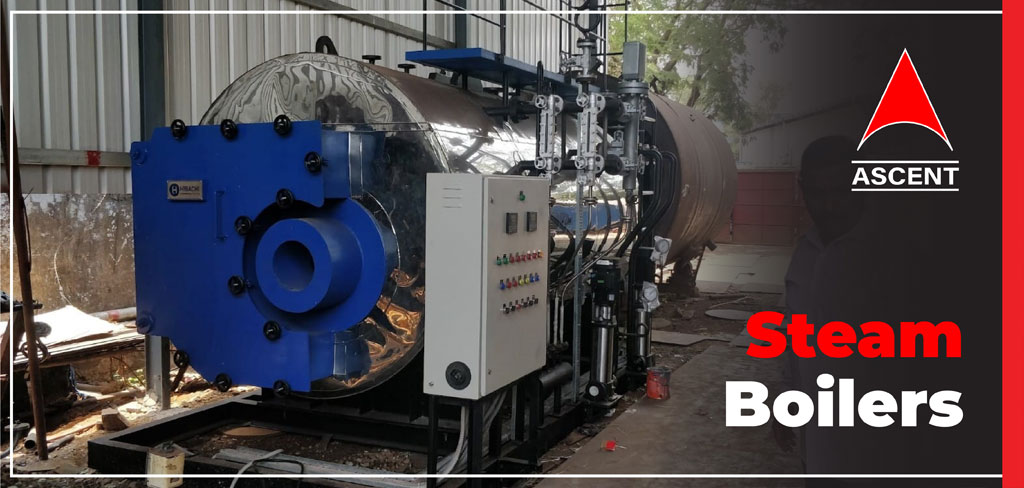
Home > Product Range > Industrial Steam Boiler and Heating Systems > Steam Boilers
A steam boiler is a closed vessel designed to convert water into steam through the application of heat. This steam is then used for various industrial and commercial applications, including heating, power generation, and process manufacturing. By utilizing fuels such as coal, oil, gas, or renewable sources, steam boilers efficiently transfer energy to meet diverse operational requirements.

Ascent Machineries & Engineering Services Ltd., based in Goregaon, Mumbai, India, is a leading manufacturer, supplier, and exporter of high-quality steam boilers. We specialize in delivering energy-efficient, durable, and cost-effective solutions tailored to meet the needs of industries worldwide. With a strong commitment to quality, innovation, and customer satisfaction, we have become a trusted name in the field of industrial heating systems.
We offer a wide array of steam boilers to cater to various industrial applications:
| Specification | Details |
| Capacity Range | 100 kg/hr to 50,000 kg/hr |
| Operating Pressure | Up to 300 psi |
| Fuel Types | Coal, oil, gas, wood, electricity |
| Efficiency | Up to 95% |
| Steam Temperature | 100°C to 450°C depending on pressure |
| Material | Carbon steel, stainless steel |
| Certifications | IBR, ISO, ASME standards compliance |
| Heat Recovery Options | Economizers, air preheaters |
| Control Systems | PLC-based automatic controls |
| Installation Type | Horizontal or vertical configuration |
| Emissions Compliance | Meets international environmental standards |
| Type of Boiler | Initial Cost | Operating Cost | Maintenance Cost | Best Use Case |
| Non-IBR Steam Boilers | Low | Moderate | Low | Small-scale operations |
| IBR Steam Boilers | Moderate | High | Moderate | Regulated industries requiring certification |
| Electric Steam Boilers | High | Low | Low | Environmentally conscious operations |
| Gas-Fired Steam Boilers | Moderate | Low | Moderate | Continuous industrial processes |
| Oil-Fired Steam Boilers | Moderate | High | Moderate | Industries with access to liquid fuels |
| Wood-Fired Steam Boilers | Low | High | Moderate | Cost-sensitive operations |
| High-Pressure Steam Boilers | High | High | High | Heavy-duty industrial processes |
| Low-Pressure Steam Boilers | Low | Low | Low | Moderate heating applications |
| Country | Cities |
| India | Mumbai, Delhi, Pune, Chennai, Kolkata |
| UAE | Dubai, Abu Dhabi, Sharjah |
| USA | New York, Houston, Los Angeles |
| UK | London, Birmingham, Manchester |
| Germany | Berlin, Frankfurt, Hamburg |
| Australia | Sydney, Melbourne, Brisbane |
| South Africa | Johannesburg, Cape Town, Durban |
| Singapore | Singapore City |
Our esteemed clients include:









The working principle of a steam boiler is based on the transfer of heat energy. Fuel combustion generates heat, which is transferred to water in a closed vessel, converting it into steam. This steam is then used to perform work or transfer heat in various applications.
Steam boilers are used in:
Industries that utilize steam boilers include:
The benefits for these industries include improved efficiency, reduced energy consumption, enhanced product quality, and compliance with stringent industrial standards.
Steam boilers are classified into various types based on:
A boiler operates as a device that heats water to generate steam or hot water, serving as a source of thermal energy for various applications.
Steaming involves transferring heat to water to reach its boiling point, resulting in the production of steam under controlled pressure and temperature conditions.
The purpose of steam boilers is to generate steam for industrial processes, heating, sterilization, power generation, and mechanical work.
The primary use of a boiler is to convert water into steam for energy transfer, industrial processes, and heating applications.
Steam boilers operate at various pressures, typically categorized as:
The cycle of a steam boiler involves:
PF Boiler stands for Pulverized Fuel Boiler, a type of boiler that uses finely ground fuel for efficient combustion.
Boilers are used for:
Designing a steam boiler involves:
An economizer is a device that recovers waste heat from flue gases to preheat the boiler feedwater, improving efficiency.
Boiler efficiency measures the ratio of heat output to heat input, indicating how effectively a boiler converts energy into steam.
PSI (pounds per square inch) is a unit measuring the pressure inside a boiler. Industrial boilers typically operate at pressures ranging from 15 to 300 psi.
The temperature of steam depends on its pressure. For example:
Boiler efficiency is calculated using the formula
The first law of boilers refers to the conservation of energy, where the heat added to the system equals the increase in internal energy plus work done by the system.
Explore our range of advanced steam boilers tailored to your industrial requirements. Contact us for expert guidance and solutions.
ASCENT MACHINERIES & ENGG. SERVICES Shop No. 2, 1st Floor, Nalanda Shopping Center, Station Road, Goregaon West, Mumbai - 400062, Maharashtra, India
+919819063898
sales@ascentmes.com
© 2025 Ascentmes.com. All rights reserved. Designed by Vebiotic Web Solutions Marketing by Adinads